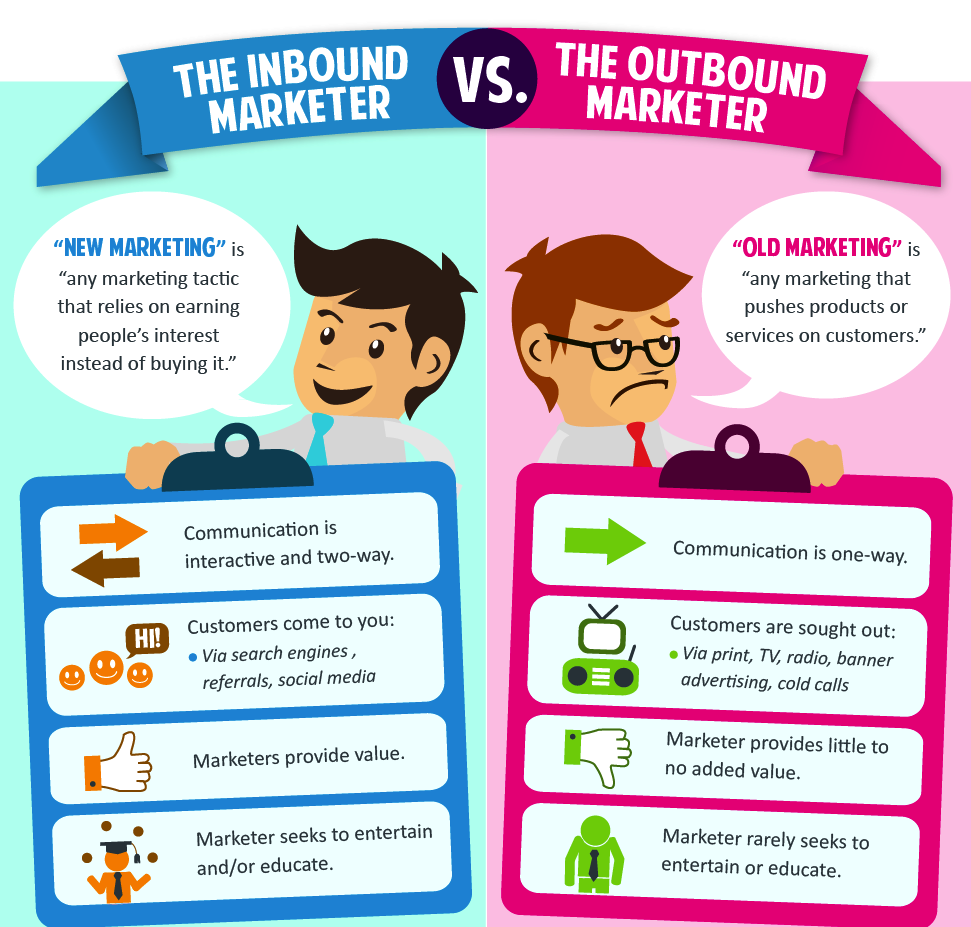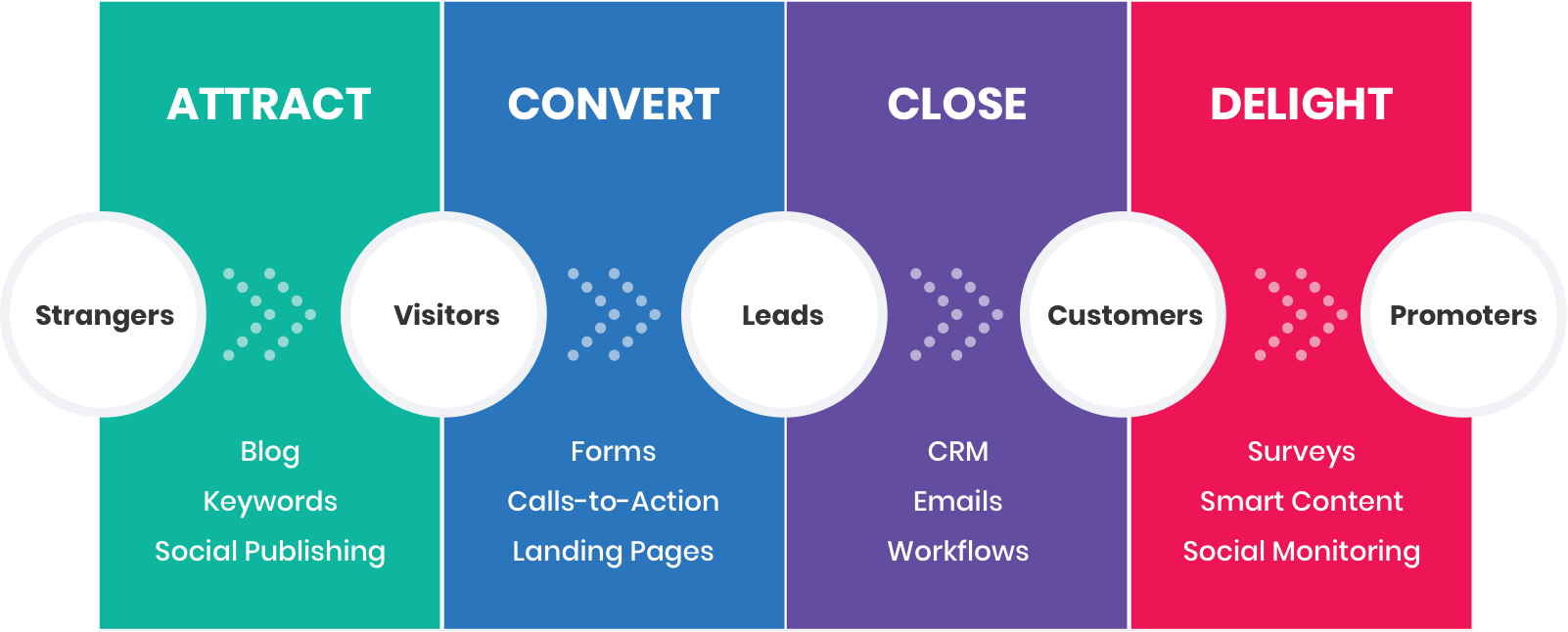Building engaging relationships with customers takes the same three things that every successful relationship requires: just the right amounts of tender, love, and care.
In the marketer’s world, relationships aren’t just limited to one’s connection with family members, friends, or colleagues. In fact, building and maintaining relationships is a huge part of the job. Your business’s growth relies heavily on the lasting relationships you develop with your prospects and customers.
Enter inbound marketing: the foundation for your audience-building and audience-engagement efforts. Inbound marketing involves forming a strategy to create brand awareness and foster long-lasting relationships with your customers. In contrast to outbound marketing, which involves marketers’ attempts to find customers, inbound marketing values the attention of customers and makes the company easily recognizable and accessible.

Inbound marketing software provider HubSpot coined the term “inbound marketing” back in 2006, defining it as the process of attracting, converting, closing and delighting customers. Inbound marketing focuses on creating valuable content, like a newsletter, that draws audiences to your brand and holds their attention.
This blog will explore the basics of inbound marketing and why it’s so vital for your business’s strategy when it comes to lead generation and fostering engaging relationships with customers.
What Makes Inbound Marketing a Must-Have?
In today’s marketing world, there’s a dichotomy between the amount of easily accessible information out there and the oft-short attention spans of audiences. The rapid pace and sheer volume at which information is churned out continues to increase while our willingness to spend much time learning decreases. We’ve become so accustomed to instant gratification, thanks to our phones and other devices.
Because of this, consumers have become more powerful in terms of determining what they consider to be relevant and interesting. The desire to share information and the need for instant gratification has turned out to be a potential roadblock for marketers and brands.
Cater to your customers
Luckily, inbound marketing attempts to solve the consequences of our increasingly fast-paced and technologically savvy society. Inbound marketing strategies give you, the marketer, the power to create content based on your consumers’ needs and build trusting relationships with leads and customers.
While other marketing tactics are fueled by the temporary attraction people may feel towards your brand after seeing an advertisement, inbound marketing allows you to attract customers during the early stages of their decision-making process. In doing so, you are able to increase your chances of long-term influence.
The benefits of inbound marketing make it well worth your time and effort. By finding the right audience for your brand, you are able to generate high-quality website and social media traffic. With the right targeting efforts, this high-quality traffic can eventually become high-quality leads and then, hopefully, loyal customers.
Establish your brand as an expert resource and increase its awareness
Since inbound marketing is all about providing potential customers with the precise information they’re looking for, you have the opportunity to position your brand with confidence and build trust with engaging, reliable content.
Inbound marketing is also useful because it helps to ensure that you’re getting quality traffic and leads from multiple channels. Persona-driven content generated by inbound marketing increases the amount of “Sales Qualified Leads” (SQL’s) by at least 45%. You’re no longer restricted to one or two places to source your audiences from.
Maintain a lasting impact
Overall, inbound marketing will lead to increased awareness for your brand and a better understanding of what your customers value most. It’s also important to remember that unlike most traditional marketing methods, inbound marketing efforts grow stronger with time. Your techniques must be repeated and nurtured across longer periods of time to show their effectiveness.
Now, let’s take a look at different inbound marketing methods and how you can get started on your strategy.
Curating a Successful Campaign
There’s not one certain inbound marketing tactic that will spark efficient and effective success. Each campaign requires a unique set of inbound marketing techniques based on what your audience considers important and interesting.
Inbound marketing features both owned and earned media to create engaging relationships with potential customers. While owned media includes channels that a business has ultimate control over, earned media encompasses the more secondary result of your brand’s initial efforts in terms of coverage. The combination of earned and owned media allows you to focus on drawing customers in and keeping them interested in what your brand can offer them now and in the future.
Most inbound marketers utilize a variety of elements to create their marketing campaigns. These elements can typically include:
- Social Media: In this day and age, you can’t afford to ignore the content that is constantly flooding social media channels like Instagram, Twitter, Facebook, TikTok, and more. Social media is a vital tool for inbound marketers, as its importance in users’ lives continues to grow and expand in new ways each and every day. The constant evolution of these platforms in terms of their purpose and their potential to provide information on everything from brunch recipes to the best shops near you has led marketers to pivot their strategies to feature a heavy focus on social media.
- SEO: Search engine optimization is another key component of inbound marketing strategy. Implementing an SEO strategy that features a well-designed site, an efficient yet effective keyword analysis, as well as other SEO practices will help you ensure that your content is being seen by those who are more likely to connect with your brand.
- Blog Content: Blogging is one of the most popular forms of inbound marketing because it allows you to create content that will drive traffic to your page and give your audience a better understanding of your brand’s identity and how your offerings are relevant to them. Blogging allows you to nurture the leads you receive through other channels while prioritizing your existing audience’s needs.
- Virtual and Live Events: Creating customized events for your audience is a great way to engage with people and help them understand what your brand stands for and how they fit into that description. Now more than ever, virtual events and webinars have increased in popularity due to the pandemic. However, virtual events are definitely here to stay beyond the lifespan of the current crisis. Digital events provide new opportunities for your brand’s inbound marketing plan and add new methods for reaching your audience consistently and easily.
These elements are just the tip of the iceberg when it comes to creating an effective and worthwhile inbound marketing campaign for your brand. What’s important to remember is that the focus of inbound marketing is your audience and how you can foster a relationship with them over the course of your brand’s development.
Steps to Success with Inbound Marketing
As mentioned earlier, inbound marketing isn’t a “one and done” kind of deal. It takes patience and dedication to implement long-term inbound marketing techniques that create results. Generating success through inbound marketing requires following a pathway that includes a series of steps, each with their own unique methods.

Each of these steps helps create and maintain relationships with customers of your brand:
- Attract: The first step in the inbound marketing pipeline involves drawing in the people who could potentially become loyal customers of your brand. During this phase, you want to think about how you can pull people in while compelling them to continue through the pathway of inbound marketing.
- Convert: During this phase, the goal is to turn those attracted audience members into qualified leads for your brand. This step requires lead nurturing tactics and increased information collection.
- Close: The third step in inbound marketing is when you are able to turn your leads into loyal customers of your brand. This effort typically involves both sales and marketing forces when your audience members are now ready to buy what your brand has to offer.
- Delight: This final strategy within inbound marketing ensures that you continue to care for your customers after they have invested in your brand. The goal is to establish a lasting relationship with your customers and promote an attitude of brand loyalty.
Through these four phases of inbound marketing, you are able to grow your business and create a lasting competitive advantage.
Taking the Leap into Inbound Marketing
Now that you’ve gained a deeper understanding of why and how inbound marketing generates success in terms of lead generation and maintaining customer relationships, let’s talk about how you can kick-start your inbound marketing strategy so you can start benefiting from one of the most important marketing tools.
Before you embark on your inbound marketing journey, there are a few key questions worth pondering:
- Who is your target audience? What sets them apart and makes them unique to your brand?
- Why should your target audience listen to you? What makes your brand stand out among your competitors?
- What’s your brand’s story? Is it compelling for your audience?
- Does the quality of your content exceed the expectations of your audience? Are you focusing more on quality or quantity of content?
- What is the best way to ensure that your audience will see your content? What platforms work best for your brand’s audience?
- What are your brand’s long-term goals? How will your inbound marketing strategy help you reach those goals and inform your future decisions?
Thinking about the answers to these questions will allow you to understand how and why inbound marketing can enhance your overall marketing strategy. By creating content that engages your audience and utilizing platforms that your audience is already accustomed to, you will increase your chances of fostering long-term relationships and turning potential leads into brand loyalists.
Inbound Is For Everyone
Inbound marketing is a must-have in every marketer’s toolkit. Discovering what works for your brand takes time and a desire to learn more about your target audience, but the benefits of implementing this kind of strategy are well worth it. When it comes to inbound marketing, it’s all about tracking the performance of your content and the constant process of refining and adapting your approach to meet the desires and needs of your audience.
Businesses throughout all different industries and stages of growth have started to realize that outbound marketing is not always enough to reach their brand’s goals and meet the expectations of their audiences and customers. Inbound marketing allows you to engage and interact with your audience on another level, and helps you build upon your brand’s reputation.
Today’s audiences have an increased desire to be involved in the conversation rather than just listen. As marketing tactics continue to evolve, it is becoming more important to utilize a wide range of campaign strategies to ensure that you are reaching the right people. Instilling inbound marketing techniques into your brand’s strategy will allow you to reach your brand’s potential and exceed your target goals in the long run!
SEE FOR YOURSELF
Watch an overview to learn how B2B marketing automation by Mirabel Technologies can help you increase traffic, optimize your funnel, drive more leads, improve conversions, and boost ROI — at a price you can afford!

